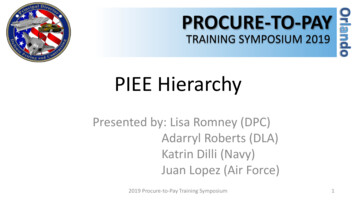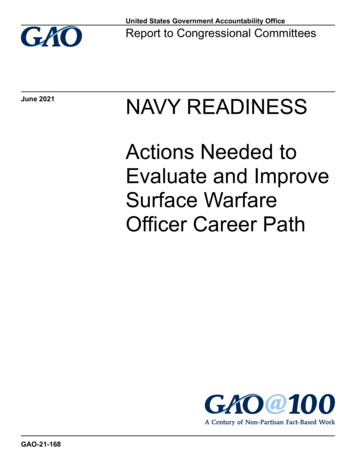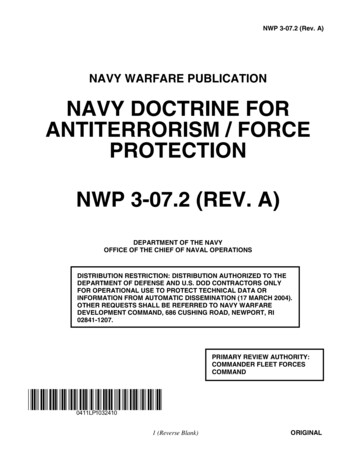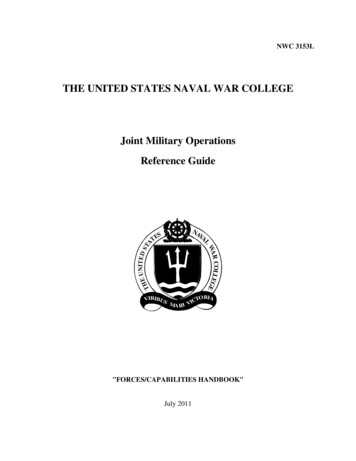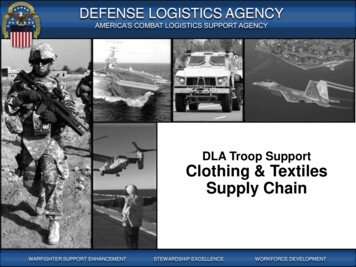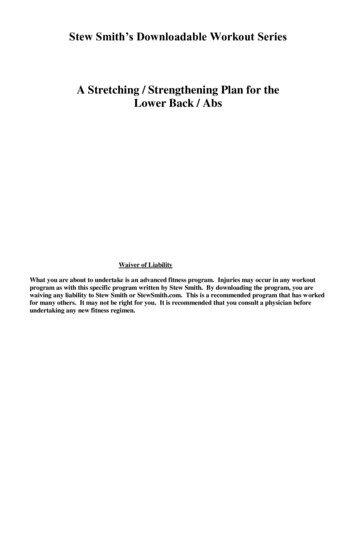
Transcription
BIOLOGICAL OPINION ON U.S. NAVY TRAINING ACTIVITIES ON EAST COAST TRAINING RANGESto promulgate regulations that would authorize the U.S. Navy to “take” marine mammals incidental to those trainingactivities. The consulting agency for these proposals is NMFS’ Office of Protected Resources - Endangered SpeciesDivision.This document presents the results of section 7 consultations on several actions that are all proposed to occur alongthe Atlantic Coast of the United States: (1) the U.S. Navy’s proposal to conduct training activities in (a) theNortheast Operating Area; (b) the Virginia Capes Range Complex; (c) the Cherry Point Range Complex; (d) theJacksonville Range Complex from June 2009 through June 2014; and (e) establishment of an enhanced TransitProtection System at Naval Submarine Base Kings Bay, Georgia, to escort nuclear-powered submarines in transitbetween NSB Kings Bay and dive/surface sites; and (2) NMFS’ promulgation of regulations to authorize the U.S.Navy to “take” marine mammals incidental to the conduct of training in the Virginia Capes, Cherry Point, andJacksonville Range Complexes June 2009 to June 2014. The National Marine Fisheries Service’s biological opinionson each of these separate actions have been grouped into this single document because of their spatial proximity andtheir potential to result in cumulative impacts (in the NEPA sense of that term) on endangered and threatened speciesand designated critical habitat that occurs along the Atlantic Coast of the United States.This Opinion has been prepared in accordance with section 7 of the ESA and is based on information provided in theapplications for the proposed Letters of Authorization, published and unpublished scientific information on thebiology and ecology of threatened and endangered whales, endangered and threatened sea turtles, Atlantic salmon,and shortnose sturgeon that occur along the Atlantic coast of the United States, and other sources of informationwhich are discussed in greater detail in the Approach to the Assessment section of this Opinion.Consultation HistoryIn January 2008, the U.S. Navy provided NMFS with a draft of its biological evaluation for training and operations inU.S. Navy Range Complexes along the east coast of the United States. In September 2008, the the U.S. Navyprovided NMFS with its biological evaluation for training and operations in three range complexes along the eastcoast of the United States: Virginia Capes Range Complex, Cherry Point Range Complex, and Jacksonville RangeComplex.On 17 March 2008, the Permits Division received an application from the Navy requesting authorization for the takeof cetacean species incidental to the proposed training activities in the Jacksonville Range Complex and VirginiaCapes Range Complex over the course of 5 years. On 12 December 2008, the Permits Division published proposedrules for these requests for authorization in the Federal Register on Friday, December 12, 2008 (73 FR 76578 and 73FR 75631, respectively). On 5 June 2008, the Permits Division received an application from the Navy requestingauthorization for the take of Atlantic spotted dolphin incidental to the proposed training activities in the Cherry PointRange Complex over the course of 5 years.In February 2009, the U.S. Navy provided NMFS with several clarifications and updates to its earlier BiologicalEvaluation. This document described several major changes to the information the U.S. Navy provided in September2008, including the addition of trainng activities off the Northeastern U.S., the addition of a Transit ProtectionSystem at Naval Submarine Base Kings Bay, Georgia, the use of anti-swimmer grenades in the Jacksonville Range2
BIOLOGICAL OPINION ON U.S. NAVY TRAINING ACTIVITIES ON EAST COAST TRAINING RANGESComplex, additional data on East Coast Navy vessel transits, clarification of maritime security operations, and arevised set of mitigation measures.On 10 April 2009, NMFS provided the U.S. Navy with a copy of the draft Description of the Proposed Action sectionof this Opinion. On 22 April 2009, the U.S. Navy submitted its comments and recommendations on that draftDescription of the Proposed Action, which triggered further discussions that were resolved during the first week ofMay 2009.On 8 May 2009, NMFS’ Permits, Education, and Conservation Divisions provided NMFS Endangered SpeciesDivision with a copy of the final draft regulations it planned to issue for U.S. Navy training activities in the VirginiaCapes Range Complex. On 10 May 2009, NMFS’ Permits, Education, and Conservation Divisions provided NMFSEndangered Species Division with a copy of the final draft regulations it planned to issue for U.S. Navy trainingactivities in the Jacksonville Range Complex. On 14 May 2009, NMFS’ Permits, Education, and ConservationDivisions provided NMFS Endangered Species Division with a copy of the final draft regulations it planned to issuefor U.S. Navy training activities in the Cherry Point Range Complex.On 2 June 2009, NMFS provided the U.S. Navy with copies of its draft biological opinion on the suite of activitiesthat would be authorized by the regulations the Permits Division proposed to issue pursuant to the Marine MammalProtection Act. NMFS has reviewed all comments on those draft documents and, where appropriate, has incorporatedthem into this document. On 4 June 2009, NMFS received the U.S. Navy’s comments on its draft biological opinionon the suite of activities that would be authorized by the regulations the Permits Division proposed to issue pursuantto the Marine Mammal Protection Act. NMFS has reviewed all comments on those draft documents and, whereappropriate, has incorporated them into this document.BIOLOGICAL OPINION1.0Description of the Proposed ActionsThis biological opinion considers several actions that have been proposed by the U.S. Navy and the National MarineFisheries Service’s Permits, Conservation, and Education Division:1the U.S. Navy’s proposal to continue to conduct training activities within and adjacent to: (a) waters off theNortheast coast of the United States, (b) the Virginia Capes Range Complex; (c) the Cherry Point RangeComplex, and (d) the Jacksonville Range Complex. For some training activities, the U.S. Navy plans toincrease the number of training events they will conduct in these areas each year. The purpose of the U.S.Navy’s training activities is to meet the requirements of the U.S. Navy’s Fleet Response Training Plan.In addition, the U.S. Navy proposes to establish a transit protection system at Naval Submarine Base KingsBay, Georgia, to escort nuclear powered ballistic submarines during transit between the Naval SubmarineBase and the dive/surface site. The U.S. Navy proposes to employ a mixture of enhanced vessel platformsand conventional weapons systems to provide protection during all transits between the Naval SubmarineBase and dive/surface sites that employs U.S. Coast Guard personnel and their ancillary equipment.3
BIOLOGICAL OPINION ON U.S. NAVY TRAINING ACTIVITIES ON EAST COAST TRAINING RANGES2the National Marine Fisheries Service’s Permits, Conservation, and Education Division (hereafter, “PermitsDivision”) proposal to promulgate regulations governing the take and importation of marine mammals,pursuant to the Marine Mammal Protection Act of 1972, as amended (16 U.S.C. 1361 et seq.), to allowNMFSto promulgate regulations that would allow it to issue annual letters of authorization to the U.S. Navyto take marine mammals for a five-year period beginning in June 2009 and ending in June 2014 incidentalto the U.S. Navy’s training activities.This document represents the National Marine Fisheries Service’s biological opinions on each of these separateactions. Pursuant to the goals of the section 7 regulations (50 CFR 402.14(c)), we have grouped these 10 differentactions into this single document because of their spatial proximity and their potential to result in cumulative impacts(in the NEPA sense of that term) on endangered and threatened species and designated critical habitat that occursalong the Atlantic Coast of the United States. Section 7 consultations on subsequent letters of authorization or thatresult from reinitiating section 7 consultation on any one of the actions considered in this document may result inseparate biological opinions in the future.1.1Training in Northeast Operating AreasThe U.S. Navy’s Fleet Forces Command proposes to continue unit level training exercises during transits to, from,and within the Atlantic City Operating Area, Narragansett Bay Operating Area, and Boston Complex. Unit leveltraining generally involves training activities by a single vessel in which the vessel uses only its own systems orsensors and includes man overboard drills, towed array operations (passive), small arms training, and surfacegunnery (inert only). Unit level training activities are conducted at the discretion of the vessel Commanding Officerif and only if the proximity of surrounding traffic permits.1.2Training in the Virginia Capes Range ComplexThe following narratives summarize the training operations the U.S. Navy plans to conduct within the VirginiaCapes Range Complex. Table 1 (which begins on the following page) identifies the specific training activities andnumber of events for each activity while Chapter 2 and Appendix D of the U.S. Navy’s Environmental ImpactStatement and Overseas Environmental Impact Statement on the Virginia Capes Range Complex provide moredetailed narratives of these training operations and specific ordnance that might be involved in particular trainingoperations (U.S. Navy 2008a).1.MINE WARFARE,which would consist of mine countermeasures and mine neutralization trainingoperations. These exercises are designed to train Navy personnel to detect, identify, classify, mark, avoid,and disable sea mines using a variety of methods. These training operations would generally occur withinareas W-50A, W-50C (including the Surface Danger Zone), W-72, W-386, and the lower Chesapeake Baytraining area (see Figure 1).4
Table 1. Activities the U.S. Navy proposes to conduct in the Virginia Capes Range ComplexRange OperationPlatformSystem or OrdnanceProposed ActionLocationW-50 A/CMINE WARFAREMH-53EMine CountermeasuresMH-60SMine NeutralizationMK-103200 sortiesSPU-1W70 sortiesMK-104120 sortiesMK-105120 sortiesAQS-24A550 sortiesW-386, W-72Lower Chesapeake BayOASIS370 sortiesLower Chesapeake BayAQS-20A670 sortiesW-386, W-72ALMDS110 sortiesW-50CDDG 91 (Remote Minehunting System)AQS-20A12 eventsW-386, W-72MH-53EAMNS70 sortiesW-50C140 sorties(30 HE rounds)110 sorties(2,750 rounds)W-50CAMNSMH-60SRAMICSEOD20 Lb NEW Charges24 eventsMK-83/GBU-32 or similarordnance (1,000 lb HE bomb)MK-20 (non-explosive practicemunitions or NEPM)5 sorties(20 bombs)34 sorties(68 bombs)28 sorties(142 bombs)75 sorties(150 bombs)25 sorties(50 bombs)22 sorties(50 bombs)Surface Danger Zone (W-50C)SURFACE WARFAREMK-76 (NEPM)Bombing Exercise (air-to-surface)F/A-18MK-82 (NEPM)MK-83 (NEPM)BDU-45 (NEPM)Bombing Exercise (air-to-surface)F/A-18, F-35 (Joint StrikeBDU-33, GBU-12, JDAM,577 sortiesW-386 (Air-K)W-72 A/BW-386 (Air-K)
BIOLOGICAL OPINION ON U.S. NAVY TRAINING ACTIVITIES ON EAST COAST TRAINING RANGESTable 1. Activities the U.S. Navy proposes to conduct in the Virginia Capes Range ComplexRange OperationPlatformSystem or OrdnanceProposed ActionFighter)JSOW, MK-76, MK-82, MK-84(all NEPM)AGM-114(Hellfire Missile HE)AGM-65 E/F(Maverick; HE)AGM-14 (Hellfire)AGM-88 (HARM)AGM-65 LSR MaverickAGM-84 (Harpoon)(77 bombs)MH-60R/S, HH-60HMissile Exercise (Air-to-Surface)F/A-18, P-3C and P-87F/A-18, F-35 (JSF) andH-60MH-53E.50 cal machine gun2.75-inch rockets8Gunnery Exercise (Air-to-Surface)MH-60R/S.50 cal machine gunM-240(7.62 mm machine gun)F/A-18, F-35 (JSF)Gunnery Exercise (Surface-toSurface; Boat)Gunnery Exercise (Surface-toSurface; Ship)Vessels such as smallunit river craft, combatrubber raiding craft, rigidhull inflatable boats, andpatrol craft40 mm grenadesCG, DDG5 inch gunFFG76 mm gunCG, DDG, FFG, LHA,LHD, LPD, LSDF/A-18Laser TargetingH-60Maritime Security Operation(to include VBSS/MIO)20 mm cannon (NEPM)Rigid Hull Inflatable Boator similar small boat, andCG, DDG, FFG, LPD or.50 cal, 7.62 mm.50 cal machine gun25 mm machine gunMaverick Laser Fire ControlSystemHellfire Laser Fire ControlSystemnone60 sorties(60 missiles)20 sorties(20 missiles)23 sorties27 sorties(54,000 rounds)97 sorties(3,700 rounds)330 sorties(264,000 rounds)165 sorties(264,000 rounds)11 sorties(7,000 rounds)36 events(220,000 small caliberrounds)36 events(600 rounds)115 events(2,430 rounds)22 events(370rounds)120 events(261,600 rounds)120 events(137,400 rounds)136 sorties136 sorties92 events6LocationW-386 (Air-K; 75%), W-72A (25%)W-386 (Air-K)W-386 (Air-K)W-72A (Air-1A; 75%)W-50C (25%)W-386 (Air-K; 75%)W-72A (25%)W-72A (Air-1A; 75%)W-50C (25%)W-72A (Air-1A; 75%)W-50C (25%)W-386 (Air-K)W-50C (90%)R-6606 (10%)W-386 (80%)W-72 (20%)W-386 (Air-K)W-72AVirginia Capes Operating Area
BIOLOGICAL OPINION ON U.S. NAVY TRAINING ACTIVITIES ON EAST COAST TRAINING RANGESTable 1. Activities the U.S. Navy proposes to conduct in the Virginia Capes Range ComplexRange OperationPlatformSystem or OrdnanceProposed ActionH-60none44 eventsF/A-18Captive carry missiles ortelemetry pods5,800 sortiesF/A-18, F-35 (JSF)20 mm cannonLocationLSDVBSS/MIO-HelicopterVirginia Capes Operating AreaAIR WARFAREAir Combat ManeuversGunnery Exercise (air-to-air)F/A-18Missile Exercise (Air-to-Air)F/A-18Missile Exercise (Surface-to-Air)AOE, LHD, CVNNATO Sea SparrowCG, LHA, AOEEvolved NATO Sea SparrowCVN, FFG, LHA, LHD,LSD, LPDCG, DDGCG, DDG, LHA, LHD,LSD, LPDAir Intercept ControlDetect-to-EngageGunnery Exercise (Surface-to-Air)AIM-7, AIM-9,AIM-120AIM-7, AIM-9,AIM-120, AIM-132 (ASRAAM)60 sorties(15,000 rounds)160 sorties(48 HE, 112 NEPM)33 sorties(33 missiles)33 RDT&E eventsW-72A (Air-2A/B, 3A/B)W-72AW-72AW-386 (Air D, G, H, K)W-386 (Air D, G, H, K)Rolling Airframe MissileSM-2SM-2 (20 missiles); SeaSparrow (2 missiles); RAM (2missiles)24 eventsF/A-18, E-2C, CVN, CG,DDG, LHA, LHDCG, DDG, FFG, LHA,LHD, LPD, LSD, CVNAir Search and fire controlradarsCG, DDG5 inch gunFFG76 mm gun (inert)CG, DDG, FFG, CVN,LHA, LHD, LPD, LSD20 mm Close-in WeaponsSystem15 events(290 rounds)3 events(72 rounds)30 events(64,000 rounds)F/A-18AGM-88(HARM)26 sorties(26 missiles)CG, DDG5-inch gun (IMPASS)22 events(1,540 rounds)Virginia Capes Operating Area370 eventsW-386 and W-72225 eventsW-386 (80%)W-72 (20%)Strike WarfareHARM Missile exercise (air-tosurface)W-386 (Air E, F, I, J)Amphibious WarfareFiring Exercise (Surface-to-Surface)with IMPASS7Preferred areas: W-386, 7C/D, 8C/D, W-72 (1C1/2)Secondary areas: W-386 (5C/D)
BIOLOGICAL OPINION ON U.S. NAVY TRAINING ACTIVITIES ON EAST COAST TRAINING RANGESTable 1. Activities the U.S. Navy proposes to conduct in the Virginia Capes Range ComplexRange OperationPlatformSystem or OrdnanceF/A-18, F-35 (JSF)ALE-50/55 electronic jammerProposed ActionLocationELECTRONIC COMBATElectronic Combat OperationsChaff ExerciseF/A-18AOE, CG, CVN, DDG,FFG, LHA, LHD, LPD,LSDSLQ-32CG, DDG, FFG, LCC,LHA, LHD, LPD, LSDMK-214 or MK-216 SuperRapid Bloom Off-board ChaffF/A-18, MH-60 R/S, F-35(JSF)R-144A/AL defensive chaffMH-60R/SR-144A/AL defensive chaffF/A-18R-144A/AL defensive chaffMH-60R/SFlare ExerciseF/A-18, MH-60R/S, F-35(JSF)Defensive flaresF/A-1810 sortiesW-386 (Air-K)110 sortiesW-386 (15%), W-72 (85%)182 eventsVirginia Capes Operating Area28 MK-214 events(168 canisters); 9 MK216 events (54 canisters)14 sorties(140 canisters)17 sorties(510 canisters)1,950 sorties(19,500 canisters)17 sorties(510 flares)8 sorties(40 flares)55 sorties(275 flares)W-386 (85%)W-72 (15%)W-386 (Air-K)W-72 (85%), W-386 (15%)W-386 (Air-K)W-386 (85%), W-72 (15%)W-72 (85%), W-386 (15%)TEST AND EVALUATIONSShipboard Electronic SystemsEvaluation Facility Utilization(SESEF)All Hampton Roadsbased shipsRadio and radar only83,800 testsVirginia Capes Operating Area (SESEF ULM-4 Rangeand RCS Range)
Figure 1. Map of the Virginia Capes Range Complex (from U.S. Navy 2008a)9
BIOLOGICAL OPINION ON U.S. NAVY TRAINING ACTIVITIES ON EAST COAST TRAINING RANGES2.SURFACE WARFARE,which would consist of bombing exercises (air-to-surface) involving F/A-18 and F-35aircraft; missile exercises (air-to-surface); gunnery exercises (air-to-surface and surface-to-surface); lasertargeting, and maritime security operations (including military interception operations and visit, board,search, and seizure operations). Air-to-surface missile exercises train aircrews to deliver missiles to surfacetargets, air-to-surface gunnery exercises train aircrews to attack surface targets with guns, surface-tosurface gunnery exercises train ship crews to attack surface targets with guns, and maritime securityoperations are designed to train Navy personnel to identify, track, intercept, board, and inspect surfacevessels. Bombing operations would generally occur within areas W-386 (Air-K), W-72A (Air-3B), and W72A/B. Some surface warfare training operations would occur in these same areas as well as within areasW-50C and R-6606. Maritime Security Operations and Maritime Interdiction Operations would occurthroughout the Virginia Capes Operating Area.3.AIR WARFARE,which would consist of air combat maneuvers, gunnery exercises (air-to-air) and missileexercises (air-to-air), gunnery exercises (surface-to-air), missile exercises (surface-to-air), air interceptcontrol, and detect to engage. Air combat maneuvers, air-to-air gunnery exercises, and air-to-air missileexercises would generally occur within areas W-386 (Air-D, G, H, K), W-72A (Air-2A, Air-2B, Air-3Aand Air-3B). Surface-to-air training operations would generally occur within areas W-386 and W-72,except for surface-to-air missile exercises, which would generally occur throughout the Virginia CapesOperating Area.4.STRIKE WARFARE,which would consist of High-Speed Anti-Radiation (HARM) missile exercises (air-to-surface) and would generally occur within area W-386 (Air-E, F,I, and J). The U.S. Navy currentlyconducts about 26 sorties for a total of 26 missiles in the Virginia Capes Range Complex each year.5.AMPHIBIOUS WARFARE,which would consist of Firing Exercises with Integrated Maritime PortableAcoustic Scoring and Simulation System (IMPASS) operations. These training operations wouldpreferentially occur in areas W-386, 7C, 7D, 8C, 8D, W-72, IC1 and IC2 with W-386, 5C, and 5D assecondary areas. The U.S. Navy currently conducts about 22 of these firing exercise events, involving atotal of 1,340 rounds, in the Virginia Capes Range Complex each year.6.ELECTRONIC COMBAT,which would consist of chaff exercises, flare exercises, and electronic combatoperations. These training operations would generally occur within areas W-72 and W-386, although someelectronic combat operations would occur throughout the Virginia Capes Operating Area. The U.S. Navycurrently conducts about 1,821 chaff exercise sorties and events, 63 flare exercise sorties, and 274electronic combat operations sorties or events in the Virginia Capes Range Complex each year.7.TEST AND EVALUATION,which consists of shipboard electronic systems evaluation facility utilization(SESEF). These training operations could occur throughout the Virginia Capes Operating Area, althoughthey are most likely to occur within SESEF ULM-4 Range and RCS Range.8.RESEARCH, DEVELOPMENT, TEST AND EVALUATION,which consists of operational test & evaluation,developmental test & evaluation, and production acceptance test & evaluation. Tests include a wide varietyof aircraft, ships, ocean engineering, missile firings, torpedo testing, manned and unmanned submersibles,unmanned aerial and underwater vehicles, electronic warfare and other Navy weapons systems. Tests are10
BIOLOGICAL OPINION ON U.S. NAVY TRAINING ACTIVITIES ON EAST COAST TRAINING RANGESused principally for equipment maintenance and to ensure that equipment within units work well whenintegrated.In the Virginia Capes Range Complex, the Navy proposes to increase training above current baseline levels; asproposed, the number of most training operations would increase by about 10 percent above baseline training levels.In addition to increasing the number of current training operations, the U.S. Navy also proposes to conduct MaritimeSecurity Surge Surface Strike Group (Independent Deployment) Training in the Virginia Capes Range Complex,although the Navy does not expect this training to substantially change the general type and quantity of operationscurrently conducted in the Virginia Capes Range Complex.In addition, the U.S. Navy proposes to use the Virginia Capes Range Complex to prepare surface ships andembarked air, special forces and Marine Corps units for deployment as Maritime Security Surge Surface StrikeGroups. Each fleet maintains a number of ships ready to deploy on short notice. Preparing a Maritime Security SurgeSurface Strike Group for deployment includes a mix of classroom, synthetic and live training events. Live trainingensures proficiency in multi-unit procedures and autonomous operations by means of anticipated region-specificscenarios. The Navy does not expect Maritime Security Surge Surface Strike Group training to significantly alter theoverall type and quantity of operations currently conducted in the Virginia Capes Range Complex.Finally, the U.S. Navy proposes to provide range support and services at the Virginia Capes Range Complex thatwould be required to accommodate additional squadrons of aircraft and new systems and weapons that would beassociated with changes in the structure of naval forces. The additional squadrons include:9.MH-60S Multi-Mission Combat Support Helicopter missions, which would include organic mine countermeasures, air-to-surface missile and gunnery operations, combat search and rescue, search and rescue,special operations, logistics support, surface warfare, maritime security operations, and chaff and flareexercises (electronic combat capability that supports all other mission areas).Most operations of the MH-60S helicopter in the Virginia Capes Range Complex would involve a singleaircraft engaged in unit-level training sorties less than two hours in duration that would begin and end atNaval Station Norfolk. When they participate in Carrier Strike Group exercises, these aircraft would deployas an entire squadron; when they participate in Expeditionary Strike Group exercises, these aircraft woulddeploy in one- or-two helicopter detachments aboard frigates, destroyers, cruisers, and amphibious ships insupport of an Expeditionary Strike Group. All of the training exercises involving these aircraft that wereconsidered in this consultation would occur at sea.10.MH-60R Multi-Mission Helicopter missions, which would include anti-submarine warfare, surface warfare,maritime security operations, and search and rescue. The Atlantic Fleet would split the projected 105airframes between Naval Air Station Jacksonville and Naval Station Mayport (Florida), distributedbetween five carrier air wing squadrons, two expeditionary squadrons, and one Fleet replacement squadron.Most MH-60R Unit-Level Training operations would occur in the Jacksonville Range Complex near theirhome bases. With few exceptions, the MH-60R would only train in the Virginia Capes Range Complexwhen they participate in major exercises. The deployment and training patterns for the MH-60R wouldresemble those discussed for the MH-60S (see preceding description) and would also include sonar training.11
BIOLOGICAL OPINION ON U.S. NAVY TRAINING ACTIVITIES ON EAST COAST TRAINING RANGESNew systems and weapons the U.S. Navy would employ in the Virginia Capes include:11.The Organic Mine Countermeasures Systems. The Navy proposes to accommodate operations of MH-60Shelicopters, surface ships, and submarines equipped with new Organic Mine Countermeasures systems inthe Virginia Capes Range Complex. This would entail some changes in tactics, techniques, and proceduresfrom current mine warfare training. “Organic” refers to the concept of embedding mine warfare capabilityinto the strike group rather than as an external capability of specialized ships and aircraft, only brought inon an as-needed basis. The Navy plans to configure 51 of the 102 MH-60Ss eventually home based atNaval Station Norfolk with Organic Mine Countermeasures capability. These systems include: Towed mine-hunting sonar (AN/AQS-20A); Towed magnetic influence and acoustic, mine-sweeping body (OASIS); Airborne mine-hunting laser (ALMDS); Submerged mine-neutralization, self-propelled devices using explosive charges (Airborne MineNeutralization System); and Airborne, mine-neutralization ordnance (designated A/AWS-2 and abbreviated as RAMICS in Navydocuments).12.The Airborne Mine Neutralization System (designated AN/ASQ-235 and abbreviated as AMNS in Navydocuments) is a non-towed system designed to identify and neutralize bottom and moored mines in theocean environment. A hovering MH-60S or MH- 53E helicopter lowers an expendable, self-propelled,neutralizer device into the water at a safe distance from a potential mine previously identified with aseparate mine-hunting system. A fiber-optic cable connected to the neutralizer relays depth, position, andsensor (sonar and video) information to the operator in the helicopter, who sends control and guidancecommands back to the neutralizer. The operator guides the lightweight (15.5 kg) and highly maneuverablevehicle to the target location using onboard high frequency sonar. After the target is viewed and positivelyidentified with an on-board video camera, the operator detonates a charge to neutralize the mine.For training and testing purposes, the airborne mine neutralization system explosive charge can be replacedwith a ballast device that would cause the neutralizer to float to the surface for recovery and reuse aftercompletion of the exercise. Training targets are expendable, non-explosive, bottom and moored mineshapes. The Navy evaluated the potential environmental effects of testing airborne mine neutralizationsystem and concluded that significant impacts would not occur (U.S. Navy 2001; 2002b).13.The Rapid Airborne Mine Clearance System (designated A/AWS-2 and abbreviated as RAMICS in Navydocuments) consists of a non-towed system designed to neutralize floating and near-surface mines. RapidAirborne Mine Clearance System is a MK44 Bushmaster II cannon with a laser Light Detection andRanging targeting fire control system that fires a flat-nosed, 30 mm, armor piercing, non-explosive, supercavitating projectile.A hovering MH-60S helicopter uses the Light Detection and Ranging system to reacquire a mine previouslylocated with a separate mine hunting system. Once the target is acquired, an onboard fire control subsystemautomatically tracks it and aims the gun, firing the projectiles in bursts. A successful neutralization would12
BIOLOGICAL OPINION ON U.S. NAVY TRAINING ACTIVITIES ON EAST COAST TRAINING RANGESdisable the mine at a safe distance from the helicopter. Training targets are expendable, non-explosive,bottom and moored mine shapes.13.AN/AES-1Airborne Laser Mine Detection System is a non-towed (airborne) mine-hunting system designedto rapidly detect, classify, and locate near-surface floating or moored mines. A pod mounted on the MH60S pylon contains the laser Light Detection and Ranging system used to detect mines. An operator on thehelicopter identifies potential mines from the laser images on a video monitor and marks their exactlocations. A separate mine neutralization system is needed to disable or destroy mines once they have beenidentified.14.The Organic Airborne and Surface Influence Sweep (designated AN/ALQ-220 and abbreviated as OASIS inNavy documents) is a high-speed (25 knots), towed, minesweeping system designed to rapidly neutralizemagnetic and acoustic mines in shallow coastal waters. It emulates the magnetic and acoustic signatures oftransit platforms, causing nearby mines to detonate. An underwater, towed body attached to a MH-60Shelicopter with an electromechanical cable contains the electromagnetic field generator and the acousticgenerator, a mechanical device that needs no external power.15.AN/AQS-20, which is a towed, mine-hunting system designed to detect, classify, and localize bottom andmoored mines in deep or shallow water. An underwater, towed body attached to an MH-60S helicopter withan electromechanical cable that contains the high-frequency, high-resolution, side-looking, multi-beamsonar system. It can also be configured with an electro-optic identification sensor that incorporates a laserLight Detection and Ranging system to identify bottom mines. An operator on the helicopter identifiespotential mines from the sonar and laser images on a video monitor and marks their exact locations. Aseparate mine neutralization system is needed to disable or destroy mines once identified.16.Increase Commercial Air Services Support for Fleet Training. The Navy proposes to increase the number,type, and operation of commercial air services within the Virginia Capes Range Complex. These contractorowned and -operated supersonic and subsonic aircraft carry a variety of electronic threat emitters, performaircraft maneuvers and flight profiles that mimic enemy aircraft, provide air-to-air refueling capabilities,and tow and stream targets used for surface-to-air gunnery training. Their use enhances the following rangecapabilities: Opposition Force aircraft against naval aircraft and ships in air defense events, such as air interceptcontrol and detect to engage, and sometimes intercept aircraft for air intercept control events; Threat missile and aircraft profiles against naval aircraft and ships in electronic combat events; Refueling tanker support during major exercises; and Tow aircraft for target banners in air-to-air and surface-to-air gunnery exercises.Incre
NAVY TRAINING ACTIVITIES ON EAST COAST TRAINING RANGES 6 Table 1. Activities the U.S. Navy proposes to conduct in the Virginia Capes Range Complex Range Operation Platform System or Ordnance Proposed Action Location Fighter) JSOW, MK-76, MK-82, MK-84 (all NEPM) (77 bombs) MH-60R/S, HH-60H AGM-114 (Hellfire Missile HE) 60 sorties (60 missiles)
